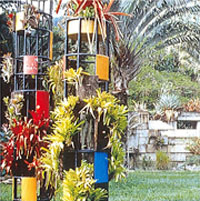
Sítio Santo Antônio da Bica
The International Carlo Scarpa Prize for Gardens
I Annual Award, 1990
The jury of the International Carlo Scarpa Prize for Gardens has unanimously decided to award the 1990 Prize to Roberto Burle Marx (born in Sao Paolo, Brazil in 1909) for the Sitio Santo Antonio da Bica (Barra de Guaratiba, Rio de Janeiro).
The site so awarded is an example of “designed greenery” which harmoniously combines image, uncompromising botanical wisdom and open-minded representational culture. And it does so thanks to an act of masterful simplification and spectacular creativity. Indeed, in the person of Burle Marx scientific research and artistic inventiveness are inseparable. The study of Brazilian botanical heritage, the identification of its peculiarities, the struggle for its preservation, the use of such patrimony as a composite language: all of these factors have run parallel through more than half a century of Burle Marx’s unflagging efforts. This site, which includes a garden, the annexed residence, an enormous spread of Brazilian flora, and a laboratory for experimentation, has come to constitute – by virtue of a generous and farsighted act – a gift to the state, and all this within the clear perspective of responsible public access.
At the core of Roberto Burle Marx’s way of thinking as well as of his work lies a deep awareness of the meaning of a possible and just relationship between man (with his history, his manner of reasoning and his imagination) and nature. This award is meant as recognition of a singular and exemplary labour whose significance transcends Brazil per se and looms as a lesson of universal worth. The award also intends to pay homage to the extremely lengthy and coherent struggle of a landscape and garden architect who is respected as of one of the foremost professionals in this century, a man whose dedication is both distinctive and fertile. Roberto Burle Marx has, in fact, shattered the imposed bonds of the classification known as “the designing of greenery”, a classification that prevented his operation from taking its rightful place within the riotous, risky and exciting world that is artistic culture; he has thereby restored his initiative to history and to adventures born of the imagination. On the other hand, he has always fought against allowing such pressures for success to evolve through reckless and outrageous manipulation of that true identity germane to trees and flowers.
It is completely logical, therefore, that he be ranked among the most rigorous champions of ecological values and among the most severe critics of the disaster wreaked on the Amazon. The International Carlo Scarpa Prize for Gardens means to highlight this role of his as well, a role consistent with the award winner’s authentic position as “an architect for the landscape”.
1990 Carlo Scarpa Prize Statement, edited by the Jury.
